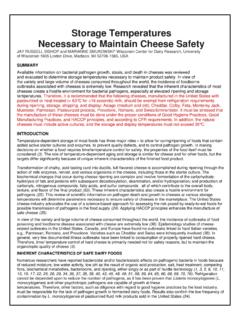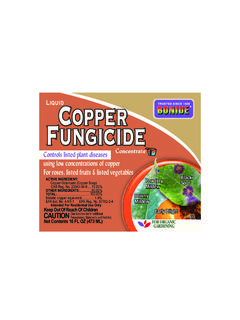Transcription of Storage Temperatures Necessary to Maintain …
1 Storage Temperatures Necessary to Maintain cheese Safety JAY RUSSELL BISHOP and MARIANNE SMUKOWSKI* Wisconsin Center for Dairy Research, University of Wisconsin 1605 Linden Drive, Madison, WI 53706-1565, USA SUMMARY Available information on bacterial pathogen growth, stasis, and death in cheeses was reviewed and evaluated to determine Storage Temperatures Necessary to Maintain product safety. In view of the variety and large volume of cheeses consumed throughout the world, the incidence of foodborne outbreaks associated with cheeses is extremely low. Research revealed that the inherent characteristics of most cheeses create a hostile environment for bacterial pathogens, especially at elevated ripening and Storage Temperatures . Therefore, it is recommended that the following cheeses, manufactured in the United States with pasteurized or heat treated (> 63 C for >16 seconds) milk, should be exempt from refrigeration requirements during ripening, Storage , shipping, and display: Asiago (medium and old), Cheddar, Colby, Feta, Monterey Jack, Muenster, Parmesan, Pasteurized process, Provolone, Romano, and Swiss/Emmentaler.
2 It must be stressed that the manufacture of these cheeses must be done under the proper conditions of Good Hygiene Practices, Good Manufacturing Practices, and HACCP principles, and according to CFR requirements. In addition, the natural cheeses must include active cultures, and the Storage and display Temperatures must not exceed 30 C. INTRODUCTION Temperature-dependent Storage of most foods has three major roles to allow for curing/ripening of foods that contain added active starter cultures and enzymes, to prevent quality defects, and to control pathogen growth. In making decisions on whether a food requires time/temperature control for safety, the properties of the food itself must be considered (3). The role of temperature-dependent aging and Storage is similar for cheese and for other foods, but the targets differ significantly because of unique inherent characteristics of the finished food product. Transformation of chalky, acid-tasting curd into ductile, full-flavored cheese is accomplished during ripening through the action of milk enzymes, rennet, and various organisms in the cheese , including those in the starter culture.
3 The biochemical changes that occur during cheese ripening are complex and involve fermentation of the carbohydrate; hydrolysis of fats and proteins with subsequent decarboxylation, deamination, and/or hydrogenation; and production of carbonyls, nitrogenous compounds, fatty acids, and sulfur compounds all of which contribute to the overall body, texture, and flavor of the final product (63). These inherent characteristics also create a hostile environment for pathogens (25). This review of scientific information on pathogen death and growth in cheeses at various Storage Temperatures will determine parameters Necessary to ensure safety of cheeses in the marketplace. The United States cheese industry advocates the use of a science-based approach for assessing the risk posed by ready-to-eat foods for possible transmission of pathogens in the food supply (24). Applying HACCP principles enhances the manufacture of safe cheese (35). In view of the variety and large volume of cheese consumed throughout the world, the incidence of outbreaks of food poisoning and foodborne disease associated with cheese are extremely low (36).
4 Epidemiology studies of cheese -related outbreaks in the United States, Canada, and Europe have found no outbreaks linked to hard Italian varieties, , Parmesan, Romano, and Provolone. Varieties such as Cheddar and Swiss were infrequently involved (38). In general, very few documented illness outbreaks have been linked to consumption of properly ripened hard cheese . Therefore, time/ temperature control of hard cheese is primarily needed not for safety reasons, but to Maintain the organoleptic quality of cheese (3). INHERENT CHARACTERISTICS OF SAFE DAIRY FOODS Numerous researchers have reported bactericidal and/or bacteriostatic effects on pathogenic bacteria in foods because of reduced moisture, low water activity, low pH as the result of organic acid production, salt, heat treatment, competing flora, biochemical metabolites, bacteriocins, and ripening, either singly or as part of hurdle technology (1, 3, 5, 6, 10, 11, 13, 15, 17, 22, 25, 26, 29, 34, 36, 37, 38, 39, 40, 43, 45, 48, 49, 51, 58, 59, 64, 65, 66, 68, 69, 70, 76).
5 Refrigeration cannot be depended upon to reduce the number of pathogens, as it has been proven that Listeria monocytogenes (L. monocytogenes) and other psychotropic pathogens are capable of growth at these Temperatures . Therefore, other factors, such as diligence with regard to good hygiene practices by the food industry, must be responsible for the lack of pathogen growth in fermented dairy foods. Results also confirm the low frequency of contamination by L. monocytogenes of pasteurized fluid milk products sold in the United States (24). INHERENT CHARACTERISTICS OF cheese Cheeses are one of the oldest types of prepared foods. Cheesemaking provided human kind with a means of concentrating and preserving milk at a time when refrigeration was unknown and principles of food preservation were vague empirical concepts at best (52). The vast majority of cheese manufactured in the United States is made from pasteurized or heat-treated milk, which renders the product free of most pathogens (38, 39, 40).
6 The inherent characteristics of cheeses made with starter culture addition provide multiple hurdles that inhibit pathogen growth (3, 47). A multiplicity of practices other than pasteurization or heat-treatment also contribute significantly to the microbiological safety of cheese (10, 11, 38). Some practices, such as milk quality management, lactic culture protocols, pH control, salt addition, and controlled curing conditions, are established technologies (38). Other factors may include natural inhibitory substances ( , lysozyme), starter metabolites and fermentation by-products ( , nisin), including organic acids ( , lactic, acetic, propionic, and formic). Water activity/ moisture content imposes additional detrimental effects on foodborne pathogens during the manufacturing and ripening of cheese (10, 11, 38, 66). During the manufacture of semi-soft, hard, and very hard cheeses, the cheese is subjected to relatively long exposure to ideal incubation Temperatures for bacteria.
7 For example, Cheddar and related varieties are maintained at 31 39 C during manufacture and are formed or hooped at Temperatures in the 32 37 C range. Many Cheddar-type cheeses are cured or aged at Temperatures up to C. Swiss cheese is held for a period of 4 8 weeks at a temperature of C to develop the characteristic eyes and flavor. If Storage of Cheddar and Swiss cheese at room temperature had any inherent detrimental effect on safety of these cheeses, then neither would be safe to consume (51). Specifically for L. monocytogenes, numerous studies suggest that the composition of cheese , ripening and Storage conditions, lactic acid cultures, pH, salt, and moisture concentration influence its survival and growth (15, 29, 39, 40, 43). The fate of L. monocytogenes and other foodborne pathogens during cheese ripening is determined by the microbiological, biochemical, and physical properties of the particular cheese (43, 64). Thus, cheese is a very complex system, with the following factors acting simultaneously to determine the behavior of L.
8 Monocytogenes during ripening: (a) type, amount, and activity of starter culture; (b) pH as determined by concentrations of lactic, acetic, formic, and other acids; (c) presence of hydrogen peroxide, diacetyl, and various antimicrobial agents (Nisin, diplococcin, and other bacteriocins); (d) levels of nutrients, salt, moisture, and oxygen; and (e) the cheese ripening temperature (64). Fermentation is an age-old food preservation method used to inhibit the growth and survival of pathogenic bacteria (48). Lactic acid bacteria commonly used to produce fermented dairy products are antagonistic to foodborne pathogens and will either inhibit their growth or inactivate them (5, 13, 36, 59, 66, 70). In addition, research has shown that some starter cultures are detrimental to food spoilage organisms as well as various pathogens in these products (1, 17, 22, 51, 58, 69, 76). Responsible for this action are metabolites such as lactic and other acids, diacetyl, hydrogen peroxide, and various antibiotic-like substances produced by lactic acid bacteria, which are probably synergistic (34, 36, 37, 45, 49, 66).
9 Examples of pathogens that are susceptible to inactivation or growth inhibition by metabolites of lactic acid bacteria include Salmonella Typhimurium, enteropathogenic Escherichia coli, Staphylococcus aureus, and L. monocytogenes (66). Growth of L. monocytogenes is always inhibited appreciably in lactic acid cultured product when compared to that of the control, no matter how high the final pH of the fermented milk. Even when the final pH dropped only to , growth of the pathogen was inhibited by 84% relative to the control (65). This suggests that factors other than the hydrogen ion concentration are involved in the inhibition of L. monocytogenes by lactic acid bacteria (65). These observations have been documented by other researchers, who noted that lactic cultures inhibited pathogens such as salmonellae and staphylococci, even when pH was controlled at (26). Modern lactic culture technology for cheese manufacturers has virtually eliminated Staphylococcus-caused outbreaks involving cheese (40).
10 Vigorous starter growth should protect fermented milk products against the growth of pathogens and the formation of staphylococcal enterotoxin (36). Mathew and Ryser (48) reported increased injury of healthy L. monocytogenes cells during fermentation; at the end of the 24-h fermentation period, > 90% of the healthy L. monocytogenes cells were injured. Additionally, at the end of the product s shelf life, > 99% of the initial population was injured, and no significant decrease in the percentage of injury was observed. It was also discovered that the presence of L. monocytogenes did not adversely affect the growth of the starter culture at any inoculation level (48). Gengeorgis et al. (25) demonstrated that non-soft cheeses made with the use of starter cultures and pH values of < , as well as processed cheeses, will not support growth of L. monocytogenes at 4 to 30 C if the cheeses are contaminated from raw foods after the consumers open packages. Rapid acid production is the principal factor responsible for the elimination of pathogens from semi-hard cheese .







